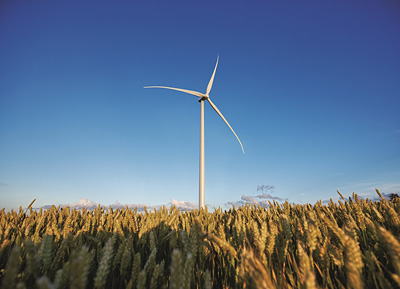New Siemens D3 Wind Turbine for High Energy Yields at Low Wind Sites

The rotor diameter of 130 meters and electrical generating capacity of 3.3 megawatts make Siemens’ new Model SWT-3.3-130 wind turbine the preferred choice for onshore sites with moderate to low wind speeds.
A growing number of onshore wind farms in Germany and throughout Europe are being sited in regions with moderate to low wind speeds. Siemens Energy is responding to this trend with its new Model SWT-3.3-130 wind turbine. Delivering 3.3 megawatts of electric power, this wind power unit extracts the maximum energy yield from low to moderate wind velocities, thereby rounding off Siemens wind power portfolio as an innovative and extremely efficient wind turbine for sites with low wind speeds. With its rotor measuring 130 meters in diameter, this giant unit will be available in early 2017.
Siemens Wind Power has injected over five years of pertinent experience gained from its D3 platform into the new SWT-3.3-130. This has enabled engineers to fundamentally rework the core components: In the new unit, the direct-drive PMG generator operates with even stronger permanent magnets to further enhance output. The designs of the nacelle bedplate, yaw drive and other components important to unit statics have been strengthened to accommodate the new 130-meter-long rotor.
While new servo-motors ensure precise rotation of the nacelle even at high wind pressures, particularly strong hydraulic cylinders in the newly designed rotor hub enable exact adjustment of rotor blade angle. The SWT-3.3-130 uses B63 blades measuring 63 meters in length. These aeroelastically tailored blades limit the static loading of the nacelle and tower, particularly under turbulent wind conditions, as the blade ends act to cushion and absorb high wind pressure. Further innovations featured in the SWT-3.3-130 include a newly designed cooling system that has now been integrated into the nacelle and ensures optimum cooling of the generator and other electrical components. Thanks to its reworked technology and 130-meter rotor, this new unit exceeds the annual energy yield of the previous D3-series wind turbine (SWT-3.0-113 / SWT-3.2-113) by approximately 17 to 20 percent.
“In our new Model SWT-3.3-130 wind turbine we have once again maximized the performance reserves which Siemens' D3 platform offers with its direct-drive PMG generator,” explains Morten Pilgaard Rasmussen, Head of Research & Development at Siemens Wind Power. “We are proud to be able to offer a highly attractive solution for sites with low wind speeds which will set whole new standards for economic efficiency, energy yield and reliability.”
Wind power and the associated service activities are part of Siemens' Environmental Portfolio. Around 43 percent of the company's revenues are generated by green products and solutions. That makes Siemens one of the world's leading providers of eco-friendly technology.
For further information on WindEnergy 2014 in Hamburg, please see www.siemens.com/press/WindEnergy2014
The Siemens Energy Sector is the world's leading supplier of a complete spectrum of products, services and solutions for power generation in thermal power plants and using renewables, power transmission in grids and for the extraction, processing and transport of oil and gas. In fiscal year 2013 (ended September 30) the Energy Sector had revenues of EUR 26.6 billion, received new orders totaling approximately EUR 28.8 billion, and posted a profit of some EUR 2.0 billion. On September 30, 2013, Siemens' Energy Sector had a workforce of about 83,500. Further information is available at: http://www.siemens.com/energy
Reference Number: EWP201409073e
Contact
Mr. Bernd Eilitz
Energy Sector
Siemens AG
Lindenplatz 2
20099 Hamburg
Germany
Tel: +49 (40) 2889-8842
Media Contact
All latest news from the category: Power and Electrical Engineering
This topic covers issues related to energy generation, conversion, transportation and consumption and how the industry is addressing the challenge of energy efficiency in general.
innovations-report provides in-depth and informative reports and articles on subjects ranging from wind energy, fuel cell technology, solar energy, geothermal energy, petroleum, gas, nuclear engineering, alternative energy and energy efficiency to fusion, hydrogen and superconductor technologies.
Newest articles

How complex biological processes arise
A $20 million grant from the U.S. National Science Foundation (NSF) will support the establishment and operation of the National Synthesis Center for Emergence in the Molecular and Cellular Sciences (NCEMS) at…

Airborne single-photon lidar system achieves high-resolution 3D imaging
Compact, low-power system opens doors for photon-efficient drone and satellite-based environmental monitoring and mapping. Researchers have developed a compact and lightweight single-photon airborne lidar system that can acquire high-resolution 3D…

Simplified diagnosis of rare eye diseases
Uveitis experts provide an overview of an underestimated imaging technique. Uveitis is a rare inflammatory eye disease. Posterior and panuveitis in particular are associated with a poor prognosis and a…





















